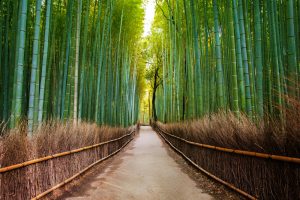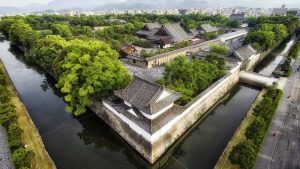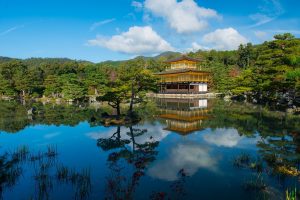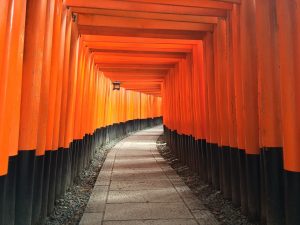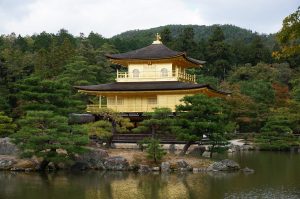Kyoto, located in the central part of the island of Honshu, is considered by many as Japan’s most beautiful city. Kyoto was the Japanese capital until the government was moved to Tokyo in 1868.
However, Kyoto is still Japan’s religious center with over 1000 Buddhist temples. Kyoto is home to some of Japan’s most iconic landmarks, with some of the most exquisite gardens, temples, and masterpieces you will ever see.
Discover Kyoto with the help of our guides. From getting around the city, where to eat, and what to see and do, our guides tell you everything you need to know.
Top attractions in Kyoto
As one of Japan’s largest cities and a top tourist destination, there is plenty to see and do in Kyoto.
To help you decide what to visit during your time in Kyoto, have a look at our detailed guides to some of the city’s best attractions.
The Arashiyama bamboo grove, Nijo Castle, and the thousand red torii gates of the Fushimi Inari Shrine are just some of the highlights.
Fushimi Inari
To your left and to your right are massive red beams with blackened footings. Above you, too, are red beams with sparklings of sunlight filtering through in between. The color, called shuiro in Japanese, is said to represent the sun. The torii gates tower above you, but lessen in number as you ascend the mountain.
When you reach the Yotsutsuji intersection, halfway up the mountain, all of Kyoto sprawls before you in a breathtaking panorama. This is what a trek on the hiking trails of Kyoto’s Fushimi Inari shrine is like.
Arashiyama
Located at the foot of the “Storm Mountains” in the north of the city of Kyoto, this world-famous, seemingly endless forest of swaying bamboo boughs is perfect for a relaxing retreat to nature during a stay in Japan.
The Arashiyama bamboo grove is open 24/7 and admission is free. The surrounding Arashiyama district, known for unique fishing methods which involve using trained cormorant birds, is also well worth a visit.
Kiyomizu-dera Temple
Kyoto’s Kyomizu-dera Temple is one of the most celebrated of Japan’s numerous temples and shrines. The meaning of its name is literally translated “Pure Water Temple”. This name is derived from the pristine waters of the Otowa Waterfall, on which site the temple was built. It is also famous for its large wooden terrace.
The Kyomizu-dera was founded in 780. Its present structures were erected in 1633. It was originally associated with one of the oldest schools of Japanese Buddhism, the Hosso sect. Since 1965, it has hosted its own Kita Hosso sect.
Nijo Castle
Another fantastic location at which to view the sakura blossom, this elegant wooden castle is one of the best-preserved from Japan’s Edo Period.
Surrounded by stone fortifications and moats, the central structure, Ninomaru Palace, was also historically well-protected from intruders by secret features such as booby-trapped floors. Can be reached in under 20 minutes from central Kyoto.
Kinkaku-ji: The Golden Pavilion
Situated in northwestern Kyoto, this UNESCO Heritage Site has a long and turbulent history dating back to 1397 and has been rebuilt numerous times, most recently in 1955.
Widely considered the most famous temple in Japan and visited by a large number of both Japanese and international tourists year-round, it is easy to access and just a 40-minute bus ride from Kyoto station.
Getting around Kyoto
Kyoto has an excellent public transport system: the city has efficient rail and bus networks. Getting around Kyoto and the surrounding areas is easy with your Japan Rail Pass.
You’ll usually be able to choose from several options to get you from A to B in Kyoto. To save time once you arrive in the city, it’s a good idea to plan transport in advance.
Our guides to trains, buses and other modes of transport will help you prepare for your visit.
Using the JR Pass in Kyoto
So, you’ve arrived in Kyoto — Japan’s cultural center. The next question is: how do you get around this remarkable city?
Taking advantage of Kyoto’s excellent public transport system is a good way to go about it! Local trains, a convenient subway, and a bus network can zip you around the city in no time.Read more...
From Kansai Ariport to Kyoto
There are numerous ways of getting from Kansai Airport to Kyoto. The easiest way is by train though there are alternatives which may be cheaper or convenient depending on your circumstances.
Kyoto is an incredible destination which is a must-see. It is considered to be the cultural capital of Japan and a major tourist destination and its numerous temples, shrines, gardens, and palaces are listed collectively as a UNESCO World Heritage Site.
The Haruka Express
The Kansai International Airport (KIX) services the cities of Osaka, Kyoto, Nara, and Kobe. If you hold a JR Pass, travel from the airport can be a simple and exciting process, as the Japan Railway West’s Express Haruka train offers direct transportation from the Kansai International Airport to downtown Osaka and Kyoto.
The JR Thunderbird Express
Picture snow covered peaks overlooking lush forests, reflecting into serene blue-green lakes. Steam rises from natural hot springs, where people gather to be rejuvenated by the warm water. Charming towns and villages housing historic architecture dot the map. This is just the ideal scene set by the Japanese Alps, a series of three mountain ranges located on the Japanese island of Honshu.
Now, imagine yourself enjoying this view while traveling to your next destination on one of Japan’s famous bullet trains.
The Sagano Scenic Railway
Western Kyoto has long been known for its natural beauty. In fact, the Arashiyama district has been a tourist favorite for well over 1,000 years. The beauty of this region peaks twice a year, first during the cherry blossom season, and later during the autumn.
Main train stations in Kyoto
Kyoto Station is a main transportation hub in western Japan. It houses 2 separate stations: JR Kyoto Station and Kintetsu Kyoto Station. The impressive glass and steel building was designed by an award-winning architect and is home to many shops and restaurants.
There are other stations that you may wish to use during your stay. Check out our guides to find out more about train stations in Kyoto and help you plan your journeys.
JR Kyoto Station
Kyoto is a city with a long history – more than 1,000 years, in fact. The construction of its primary train station, Kyoto Station, took place during the city’s 1200th anniversary and opened to the public in 1997.
Designed by acclaimed architect Hara Hiroshi, Kyoto Station is futuristic and modern. It is one of the largest buildings in Japan. Filled with interesting restaurants, shops, and attractions, a visit to Kyoto Station is a miniature vacation in itself.
Itineraries and nearby attractions
To get the most out of your stay in Kyoto, it’s important to have an itinerary. We’ve put together several options depending on how long you will stay in the city and which attractions you’re interested in seeing.
Using our itineraries, you can make the most of every minute of your time in Kyoto. Don’t miss out on any of the best sites, and enjoy some of the finest cuisine the city has to offer.
Things to do in Kyoto
Many travellers ask us: what to do in Kyoto? If you are visiting Japan for a week, three days in Tokyo and three days in Kyoto are perfect to explore the two great capitals of Japan: the ancient and the modern one.
Following is a pleasant 3-day Kyoto travel guide, with ideas about what to see, where to go and how to use your Japan Rail Pass to move through the city, its temples, gardens, and geisha alleys. Let us begin!
Kyoto to Osaka and Tokyo
Japan is one of the most culturally rich and diverse countries on Earth. When exploring through the streets, hills, and castles of Tokyo, Kyoto, and Osaka, you will be taken through time, history and places of breathtaking views and mesmerizing moments.
In this article, you will find how to make the following journeys around Japan — some of the most popular train trips among travelers:
- Tokyo to Kyoto
- Tokyo to Osaka
- Kyoto to Osaka
You can travel between these 3 incredible cities with the bullet train and using just your Japan Rail Pass.
The Philosophers Walk
The Philosopher's walk, also known as Tetsugaku no Michi, is a pedestrian route located in the Northern Higashiyama district of Kyoto that stretches for around 2 kilometers along the Lake Biwa Canal among stunning natural scenery.
The path was named for Kyoto University professor and influential 20th-century Japanese philosopher Nishida Kitaro, who is said to have used the route for a daily meditative walk, and nowadays is well-known as a popular cherry blossom and autumn foliage viewing location.
Day trips and nearby destinations
While there’s lots to see and do in Kyoto city center, you might also want to explore the surrounding areas. There are many interesting nearby towns that you can visit on a day trip to Kyoto.
Here you’ll find guides to some of the most popular places close to Kyoto and how to get there. If you’re spending a few days in the city, these are great options to see a bit more of Japan during your vacation.
Himeji Castle
Built in 1609, Himeji castle is one of the most highly regarded castles in Japan, in part because of its immense size and the fact it has survived centuries of natural disasters and wars.
Also known as ‘White Heron Castle’ because of its distinctive pale facade, this UNESCO World Heritage Site is located close to the city of the same name and is also easy to reach by Shinkansen from Kobe, Kyoto, or Osaka with a JR Pass.
Byodo-in Temple
Byodoin is a stunning Buddhist temple located in the small city of Uji. There is an incredible amount to see at the UNESCO World Heritage site which has drawn visitors for over 1000 years.
It’s such an iconic landmark in Japan that it appears on the 10 yen coin.
Along with its garden, the temple represents the “Pure Land Paradise” and its design was highly influential on subsequent temple construction.
Uji
Situated between Kyoto and Nara, Uji is famous for being the home of a Japanese staple, green tea, which was first cultivated in the region in the 12th Century.
The town also offers a range of historic architecture to explore, including a number of rustic temples and the oldest Japanese shrine still in existence.
Kobe
Kobe is a coastal city of the Kansai region of western Japan, located on the main island of Honshu bordering Osaka Bay. It is one of Japan’s ten largest cities. Enclosed by the sea on one side and a majestic mountain range on the other, it is also considered one of Japan’s most beautiful big cities.
Kobe is rich in history as the first port in Japan to open to foreign trade. This is evident in the western style architecture of some neighborhoods. Recent history is displayed at the Kobe City Museum and the Earthquake Museum.
Osaka
Osaka is located on the main island of Honshu, roughly in the center of Japan. With a population of over 2.5 million people, it is Japan’s third-largest city.
Osaka was the country’s first capital, and to this day it is considered a vital economic center in Japan. It is home to the largest seaport in Japan and many leading Japanese manufacturers.
Nara
Nara is an ancient city located in the Kansai region of Japan’s main island of Honshu. It was the first “real” capital of Japan, remaining such for less than a century. This historic location is home to a nearly unmatched eight UNESCO World Heritage Sites, including numerous Buddhist temples. The city was founded in the year 710 C.E. and originally known as Heijo.
Among its attractions are the oldest and largest wooden buildings in the world, the Nara Deer Park whose tame deer delight in entertaining visitors, fantastic cherry blossom viewing spots, and ninjas.


